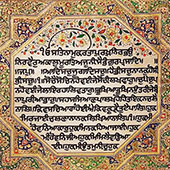Design Resource
Gurmukhi Manuscript - Style Writing
Ik Onkar Passion Project Development
by
These manuscript-kind dense compositions in writing practice represent a connection of the letter’s form and it’s sound image. This made the design practice a meditative, process-centric activity to fine-tune form-content relationships and receive insights about the cultural associations with Punjabi language (verbal and written meanings). Most among the 35 akhars belong to two categories; prominence of one may be more dominating than the other.
Following four categories emerged in the meditative writing practice:
- Shared Features [SF]:
In writing (the letter formation) as well as sound-wise, there are few letterforms in
Gurmukhi that resemble those in the Devanagari script; making this a category of
Shared Features [SF]. For instance, ‘Ga’gaa’ / ਗ resembles Devanagari ग (Figure 12).
Figure 12. Writing Practice of ‘Ga’gaa’ / ਗ resembles Devanagari ग
- Conflict Features [CF]:
In addition, there are few letters in Gurmukhi that are visually same as those in Devanagari, but differ in sound. Both sound and form-wise, it's harder to recall and retain their correct sound image and hence, the form while writing. This second category has been observed as ‘Conflict Features’ [CF]. For instance, ‘Sa’saa’ / ਸ resembles Devanagari म and ‘Ka’kaa’ / ਕ that resembles Devanagari र (Figures 13 and 14).
Figure 13. Writing Practice of ‘Sa’saa’ / ਸ that resembles Devanagari म
Figure 14. Writing Practice of ‘Ka’kaa’ / ਕ that resembles Devanagari र
- Expressive Forms [EF]:
The manuscript style written compositions of few other sets of letters make understand the significance of visual expressions in the letter formations. For instance, gurmukhī. the fifth letterform (akhar) in "haa'haa" / 'h' as in home. The wit of ਹਾਹਾ: both in visual form and pronunciation represents an equal emphasis over both syllables that are pronounced so that when is the happy-go-lucky: ਹ -- ਹਾਹਾ spoken there is a puff of air felt when the hand is held in front of the lips. The Romanized spelling of Haahaa is phonetic and may also appear spelled as Haha (Figure 15).
Figure 15. Writing Practice of ‘Ka’kaa’ / ਕ that resembles Devanagari र
- Aesthetic Forms [AF]:
A binary opposite to such sets are those individual letter set chains that communicate a distinct aesthetic and letter construction stylizations. For instance, the fourth letterform (akkhar) in ਸ is a stylized & condensed म of the Devanagari script. The knot of the Devanagari म has been pulled down to resemble an exaggerated teardrop terminal in the gurmukhī ਸ (Figure 10). This transformation of the knot to a teardrop terminal that almost touches the baseline with the stem of ਸ is indicative to a novice too that there’s some distinction between these similar looking type forms. Another beautiful and striking letterform is that of ੲ / ਈੜੀ / Ee'rhee e' as in ‘energy’ (Figure 16).
Figure 16. Writing Practice of ੲ / Ee'rhee: sharp, energetic, disciplined in structure.
- Introduction
- Holy Gurmukhi Script - Birth and Developments
- The Gurmukhi Akhars / Alphabets
- The Patrons and Manuscript-Style Written Granths
- The Traditional Lipi and Writing Practice with Paintī (35) Akhars
- Culture-Form Associations
- Categorization in the Ik Onkar Series
- The Personality Mapping
- Digitizing Few Selective Akhars
- Conclusions
- References
- Downloads
- Contact Details
- Credits











